A plant-eating dinosaur always had the risk that it could be hunted by carnivores. Naturally, it could try to hide or to stay out of areas known to have lots of predators, but eventually, there would be encounters with hungry meat-eaters. That sparks the imagination to ask, how did dinosaurs protect themselves, and by what methods? Could a plant-eating dinosaur escape or fight the predator off? Fossils suggest that dinosaurs did have defense mechanisms and used them.
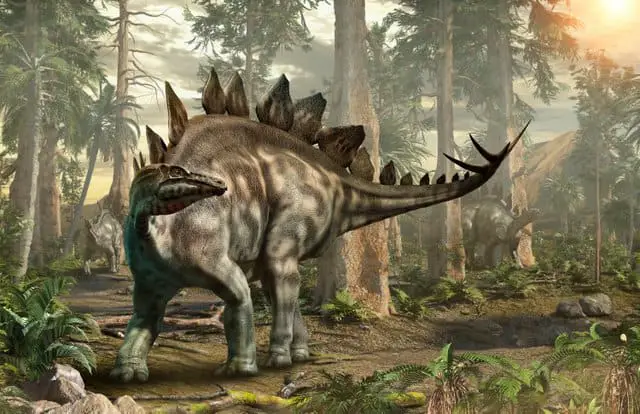
How Did Dinosaurs Protect Themselves?
So how did dinosaurs protect themselves? To defend themselves, dinosaurs had natural defense mechanisms in place – claws, head shoves, whipping tails as well as speed and a larger size. To protect themselves, they also adapted body armor and weapons such as horns, plates, and spikes that were distributed from head to tail. Scientists are also finding fossils that indicate body-color shading used as camouflage.
Plant-eating dinosaurs protecting itself from an aggressive carnivore is not an easy thing to do. Predators such as T-Rex, Velociraptor, and Allosaurus had strong jaws and sharp teeth developed for ripping and tearing flesh. Let’s take a closer look at precisely what those defense mechanisms that dinosaurs used to protect themselves.
Table of Contents
Dinosaur Defense Mechanisms – How Did Dinosaurs Protect Themselves Naturally?
Plant-eating dinosaurs were known as herbivores, meaning they ate only plants and vegetation. The natural defense mechanisms for herbivores, most of them had, needed to be ready to use at any moment. Although some of them developed further, they needed to use them as they were. Additionally, even though there is no concrete evidence that herbivores used these natural mechanisms, we have gained insight by observing modern-day reptiles and mammals.
Claws
Dinosaur claws were hard and stiff. Although we don’t know for certain, scientists believe they were made of beta-keratin. As they were hard and sometimes sharp, they could be used against predators. By slashing and scratching, the herbivore dinosaur could protect itself against the hungry velociraptor, although probably it was not enough to make a mortal wound. It would be used to deter and get away from the predator. Here are a few examples of claws that were further developed and possible uses for them against predators.
● Therizinosaurus – This dinosaur had a pair of unique modified claws. The claws were longer than comparative claws. Some theories suggest those claws were just to help with eating, but some evidence shows they had used claws to protect themselves.
● Iguanodons – had a strangely developed long spike both of their thumbs. Again, it is suggested that the primary purpose of this thumb was to hold food, but it could also be used to defend themselves against carnivores.
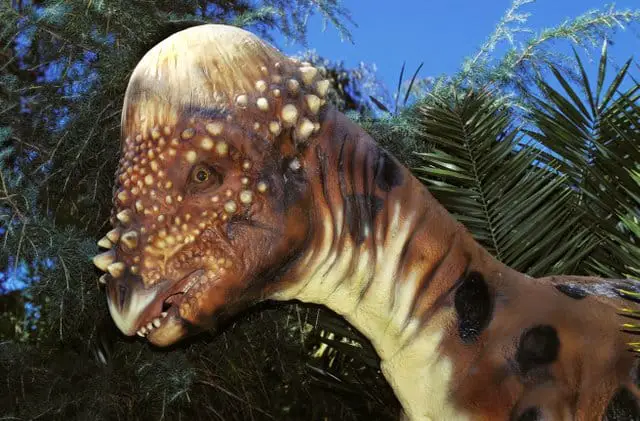
Head and Neck Shove
Herbivores did not have sharp teeth for ripping flesh, so it would be ineffective to use during a fight. However, the use of the head and neck to “bat away” or “hit” the predator could be effective. We see this in modern-day mammals as giraffes use their neck as defensive weapons during fights.
Using the head and neck might also be effective in protecting themselves if the size and weight of the plant-eating dinosaur were big enough, or even better, bigger than the predator.
Whipping Tail
Similar to using the head and neck to “bat away” a predator, whipping the tail against it could startle and deter them from attacking. This is also a way how did dinosaurs protect themselves. Many dinosaurs produced tails that were even a few meters long, and the whipping force (if the dinosaur was big enough) could be effective.
One drawback of a whipping tail, however, is that the dinosaur would have to turn its back to the carnivore slightly. It might prove to be a bit risky, but if it helped to deter the carnivore, it would be worth it.
It is known that some alligators and crocodiles use their tails for defense. Even though their tails are used primarily for propelling themselves through the water or digging away dirt, it can effectively be used as a whip.
What Kinds of Armor Were Used by Dinosaurs? More About Dinosaur Horns, Spikes, Clubs and Armor Plates
Different dinosaurs had a different set of weapons and armor to it from danger.
So far, more than 30 dinosaurs have been found with different kinds of armors just on their back to survive an attack against the predator. One of the vulnerable places on a four-legged herbivore dinosaur was its soft underbelly, and armor evolved, for instance, spikes on the sides of the dinosaur, to protect it. The heavy armor also made it heavier, so that it was more difficult for a predator to turn them upside-down.
With the development of weapons like horns, spikes, clubs, and armor on the herbivore’s head, back and tail, it could be combined with the natural defenses. As you read about these weapons, imagine head shoves and whipping tails used together with weapons, which could produce significant defense against carnivores. Let’s examine these in more detail.
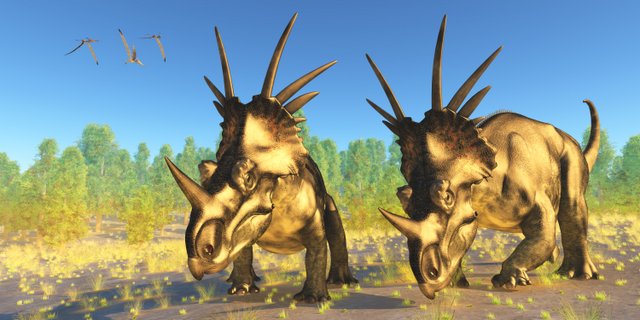
Horns – The Horned Dinosaurs
What can be more frightening than a dinosaur with a horn? A dinosaur with three horns charging at you!
Horns were commonly made of hardened bone and were long and sharp. They often protruded from the forehead of the dinosaur or at the top of the nose. The Ceratopsian dinosaurs evolved horns on their head and sometimes had a combination of spikes on the “head shield or frill”. Here are a few of the most well-known with some details:
●Triceratops – One of the most well-known of the Ceratopsian dinosaurs, the Triceratops had two long horns protruding from its head and a third shorter one on the top of its nose. The bony frill, different lengths depending on the species, covered the body. It’s skull, in some species, took up one-third of the length of the dinosaur.
●Centrosaurus – This dinosaur looks like a Triceratops, except it has only one long horn above the nose and bony spikes along the spine of the dinosaur.
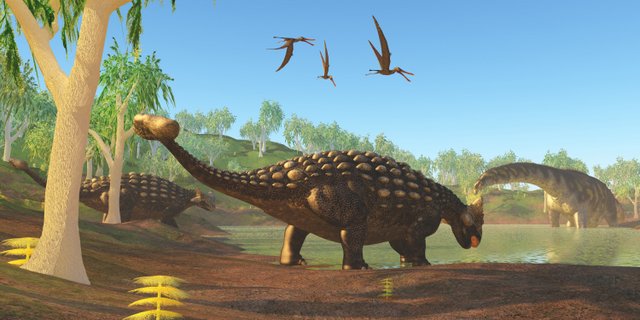
Body Armor, Frills and Plates
Body Armor
The body armor used by some herbivores consisted of bony plates in the skin, which scientists call osteoderms. It’s found in modern-day armadillos and alligators. Others had hard defensive scales that were tough to penetrate. Dinosaurs that used body armor in this way were:
● Ankylosaurs – One such dinosaur, the Nodosaur (which is a subspecies of Ankylosaur), had body armor covering its entire back. The most famous Nodosaur fossil, which shows the amazing body armor, was found by miners in Canada. Source.
Frills
A frill is the shield on the neck of the dinosaur, which often had spikes. The frill shields were made of bone. It served to protect the body of the dinosaur and is another way how did dinosaurs protect themselves. It made the dinosaur also look bigger from the front. The Stryracasaurus is a herbivore dinosaur that had a large frill with multiple spikes that protected its body.
Plates
Some dinosaurs noted for having plates standing vertically from the head along the back and tail. These plates were made of bone. Dinosaurs that had plates were:
● Stegosaurs – Initially, when paleontologists discovered the fossils, they thought the large plates were body armor that lay flat on the dinosaur, but later found they stand vertically. The Stegosaurus, the most well-known Stegosaur, was as big as a bus and had two rows of the plates across its back.
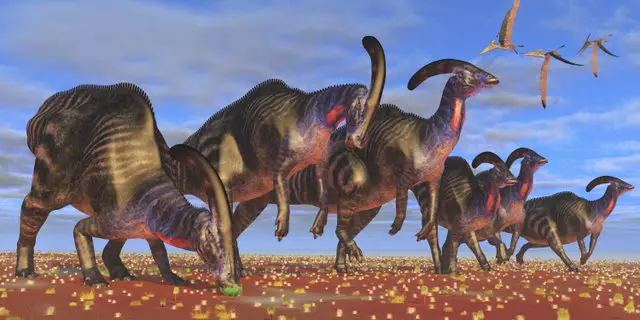
Spikes
Spikes were also made of bone. Some dinosaurs that had spikes were:
● Kentrosaurus – It had lots of spikes all along the body from the head to the tail, and some on the side. Certainly, it would be difficult for a predator to hurt it without being hurt itself
● Pachycephalosaurs – This dinosaur had a hardened bone head, which also had thick spikes. It likely used its head as a battering ram against a predator.
● Dracorex – Had small spikes on the head. A two-legged dinosaur and was also considered to look like the mythical dragon, except without wings. I wrote an article about the difference between dragons and dinosaurs on this website, check it out here: What’s the Difference Between Dinosaurs and Dragons?
● Parasaurolophus – This dinosaur had a curved crest on its head. The crest was made of bone. It could use its head as a protective weapon.
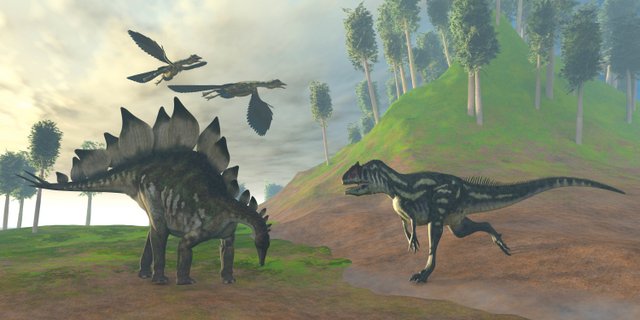
Clubbed or Spiked Tail
● Clubbed Tail – Ankylosaurs were armored dinosaurs that had special modifications. Besides unbreakable armor, they had a hammer-like tail. The first half of the tail was flexible, which allows the tail to swing around. At the end of the tail, there was a club that was made of hardened bone. It was used to break food and to defend against enemies.
● Spiked Tail – Another species, the Stegosaurus, had a flexible tail with four long sharp spikes at the end of it. By swinging its tail, it became a weapon to use against predators.
How Did Dinosaurs Protect Themselves Using Camouflage, Size, and Speed?
Other perspectives on how did dinosaurs protect themselves are in using specific advantages they might have as a default of their species. The types of color, size, and speed are often unique to different species, and these could well have been used to outwit or outrun a predator.
Coloring and Camouflage
Modern-day animals use coloring and camouflage tactically to escape the eyes of hungry predators. So, it’s not too far a stretch to imagine that dinosaurs could use similar tactics to escape hungry Velociraptors looking for prey. Up until recently, we didn’t have proof of different coloring in dinosaur fossils.
In 2016 the discovery of a Psittacosaurus gave some concrete proof that dinosaurs also used coloring and camouflage, according to National Geographic. The Psittacosaurus had a darker topside color on its back and a lighter color on its belly.
————————————————————————————————
Related Dinosaur Articles You Might Also Be Interested In:
Would A T-Rex Really Shake The Ground?
What’s the Difference Between Dinosaurs and Dragons?
How Would A T-Rex Get Up After Falling?
————————————————————————————————
Size
If a dinosaur was attacked by a carnivore with sharp teeth and claws, but instead of being smaller than the carnivore, it was considerably larger, how would that change the fight? Most likely, it would make a difference. Used in combination with the natural defense mechanisms or weapons, it would probably make the predator think twice about attacking.

It’s worth noting that the Sauropods – those enormous, long-necked dinosaurs such as Diplodocus, Brontosaurus, Apatosaurus, and Brachiosaurus – were extremely large and tall. They could use this to their advantage, possibly even crushing their attackers.
Speed
The long legs of some herbivores gave an advantage in terms of speed. It enabled these dinosaurs to escape from predators with greater ease. One of those dinosaurs, the Dromiceiomimus, was estimated to reach a speed faster than 38 miles per hour (60 kilometers per hour).
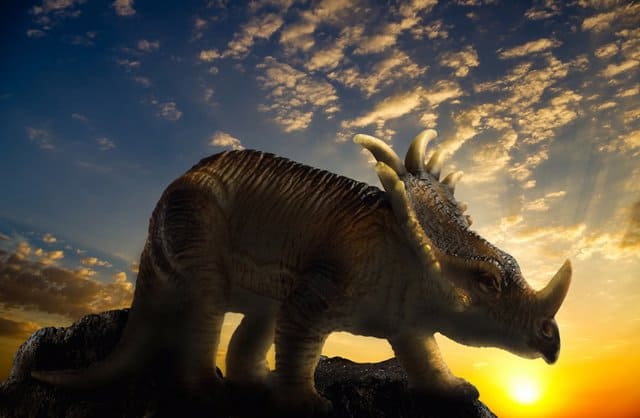
Final Thoughts
It’s always interesting and even exciting to imagine how these amazing looking dinosaurs such as the Ankylosaurus or a Triceratops could protect themselves against vicious predators like the Allosaurus or the Velociraptor. Knowing more about the defense mechanisms like body armor or frills gives us better clues about how they were used. Further, as we discover more species, it’s incredible to see how many different variations and combinations there are. Body armor and spikes mean a lot more to me than it used to!
